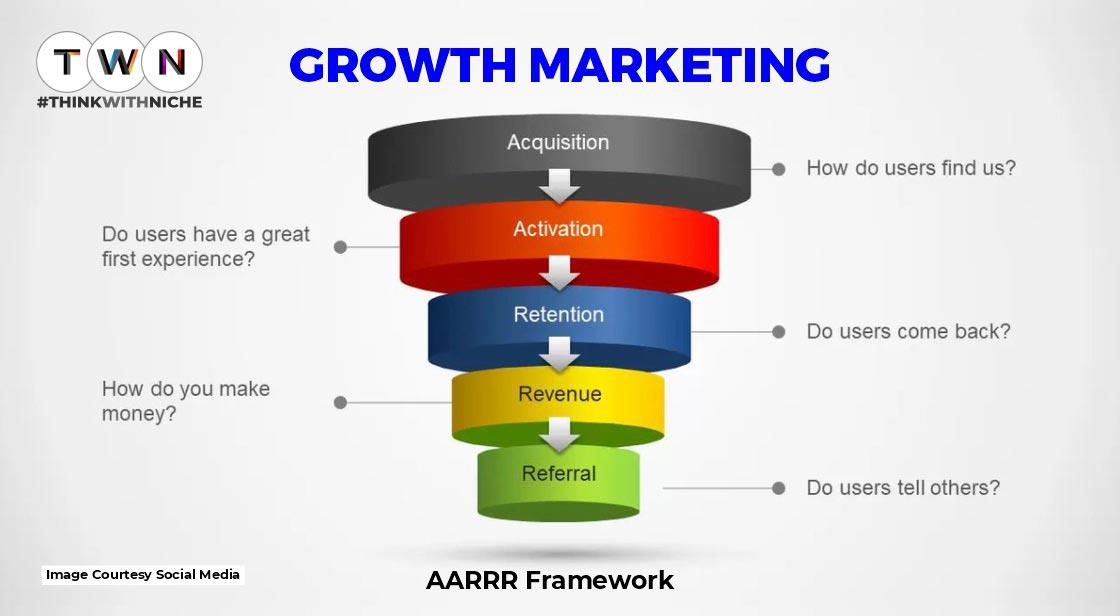Step by Step Guide to execute AARRR Framework of Growth Marketing

Blog Post
Growth marketing is the hot topic of this decade. Marketing was already enough for people to understand, and now they have to deal with growth marketing as well. We are here to make you understand the growth marketing strategy and how to get a higher conversion rate. This article which you are about to read is for everyone who finds it hard to understand the concept of growth marketing due to various roadblocks. Today, we will talk about two major sub-parts of this new emerging marketing technique:
- The funnel Concept
- The AARRR Framework
#TWN
Growth marketing is the hot topic of this decade. Marketing was already enough for people to understand, and now they have to deal with growth marketing as well. You might wonder, isn’t this topic a bit more difficult & overwhelming? Yes, it is, and that’s why we are here with this blog to help you learn about it.
This article which you are about to read is for everyone who finds it hard to understand the growth marketing strategy due to various roadblocks. Today, we will talk about two major sub-parts of this new emerging marketing technique:
- The funnel Concept
- The AARRR Framework
These are the stepping stones of growth marketing. So, you must know these before learning something else in this field.
Before all that, you must learn about a concept that marks the beginning of funnel marketing. It is the conversion concept.
What is the Concept of Conversion?
In marketing, conversion occurs when a customer responds to marketing content and acts in the manner intended by the marketer. In other words, all marketing-related actions are conversion actions. It could be anything from viewing a landing page to following social media profiles, signing up as a member on a webpage, buying items, and so on.
Sadly, most marketers still regard the purchase conversion as the only considerable conversion. Of course, it would indeed be ideal if we could increase conversion rates solely through short-term marketing. Even if we gather all of the employees, trying to improve the purchase conversion rate in a brief span of time will be difficult. Improving such a tough challenge with only a few team members is even more difficult.
So, which conversions must we monitor and optimize?
For that, we will introduce a key concept that is called the ‘funnel.’
Also Read: 5 Steps to Your First High-Growth Marketing Funnel
The Funnel Concept, A Service of Growth Marketing
A funnel is a process by which customers recognize and purchase a product. The name was chosen because the way the number of individuals decreases from the wide entrance toward the later point resembles a narrow funnel.
The funnel model differs depending on the industry, corporation, and advertising goal. There are different funnels for each situation, ranging from relatively simple low-involvement goods to high-involvement products that require a significant amount of time and complex steps before purchase.
The aim of designing the funnel, however, remains the same. The focus is to enhance the conversion rate at every stage of the marketing funnel, ultimately increasing the conversion rate at the final phase, the purchase conversion rate.
In other words, the main objective is to make the funnel smoother by improving it at each stage.
To achieve that objective, now the AARRR framework comes into play.
The AARRR Framework
Because the funnel concept is crucial in business, related research is being carried out extensively. Let's look at the AARRR funnel as one of the various funnel theories.
The AARRR indicator was created by Dave McClure, the creator of the American Startup Accelerator 500 STARTUPS. It is an effective model for determining the current state of services and developing strategies to identify weak points. As a result, it is especially beneficial for startups that lack manpower and time.
The AARRR has five major steps as denoted in the word itself. Let’s take a look at it.
- Acquisition
- Activation
- Retention
- Revenue
- Referral
Now, let’s get into the details of the AARRR framework.
Acquisition
The acquisition is the process by which people discover a product, service, or brand and ultimately become customers. It is critical to precisely monitor website traffic and website data for this segment of statistics. How many people visit the website on a regular basis? Just how many of these visitors make a purchase?
It is critical to track the user experience through the funnel rather than just the conversion rate. Every micro-conversion made along the way is also valuable. The term "micro-conversion" refers to the small phases of the process.
The tools that are used during the acquisition step are:
- SEO
- SEM
- Social networks
- Blogging
- Web Apps
- TV
Activation
Activation & acquisition statistics sometimes overlap. The first interaction a consumer has with a good or service is referred to as activation.
It is the customer's lightbulb moment. When he or she realizes that there is genuine value in a product and comes back for that reason. In a nutshell, the activation statistic is the time between a user's first encounter with a product and their aha moment.
Also Read: Key Factors To Keep In Mind While Creating Creative Office Workspace
Customer conversion is mentioned under acquisition because anyone who signs up for a subscription is occasionally converted to a client, even if the potential is not always used. This varies according to the type of business. For an e-commerce firm, activation is more important after a micro-conversion than after a full conversion.
Tools used for activation are:
- The homepage that converts customers effectively
- Efficient landing pages which provide a controlled experience to customers
- Product characteristics and properties that provide value to current customers while also attracting new customers.
- Tutorials
Retention
Retention is concerned with the question of how many clients are retained and why some are lost. Customer retention reveals a lot about the marketing efforts of a company. Customer retention refers to existing customers returning to use a product on a regular basis.
For an e-commerce firm, this means that a customer makes multiple purchases. This means that app users will log in more frequently. Customer churn is the inverse of customer retention. It is critical to monitor statistical data for both customer retention and customer churn.
In some ways, the customer retention to customer churn ratio indicates if a company has a good product mix and has reached its target market. Something is seriously wrong if many clients return the item and have used it for the first time. These customers, however, are an excellent source of understanding and knowledge. The customer churn rate must be much lesser than the customer retention rate. For many businesses, it's the only way to expand.
This is why selling a product to an existing customer is much less expensive than selling an item to a new one. It is critical to keep in touch with customers on a regular basis, whether through special offers, mailings, private messages, or other means.
Tools needed for the retention of customers are:
- Blogs & Vlogs
- Telecommunication
- Gamification
- Push notifications
- Emails
Revenue
Your company will eventually need to generate revenue, so you should consider how many people become paying customers. With the increase in revenue, you can put that money into R&D and make better products to lure in main customers and retain them.
Referral
The AARRR Framework refers to the question of how to make sure that our clients will suggest us to others. This is the most effective way to encourage growth. If all of a company's customers recommend its product or service to others, the company no longer needs to do anything in this vicinity.
To encourage referrals, the company must have a consistent process in place that stimulates & generates consumer engagement and referrals. Dropbox used referral incentives and discovered that this was among the major driving forces behind its growth.
Tools you can use for referral are:
- Giveaways
- Emails
- Campaigns
- Referral marketing
Also Read: Successful Strategies For A Saturated Real Estate Industry
FAQs related to AARRR Growth Marketing Strategy
What is the AARRR framework of growth marketing exactly?
The AARRR framework has five components: acquisition, activation, revenue, retention, and referral. Since the Pirate Funnel was too sales-focused, Awareness was added later. So, now it is known as the AAARRR strategy.
What is the Pirate Funnel in marketing?
The Pirate Funnel is a framework based on performance measures that directly contribute to a company's health and uses data to determine what works well about a good or service and its marketing.
You May Like
EDITOR’S CHOICE












